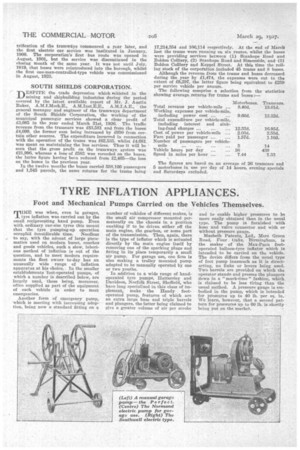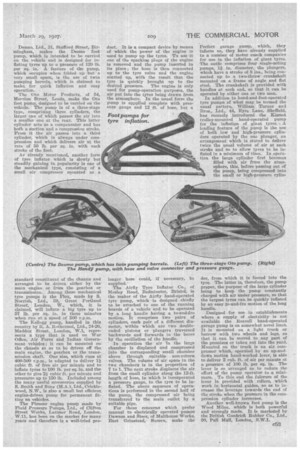TYRE INFLATION APPLIANCES.
Page 122

Page 123

If you've noticed an error in this article please click here to report it so we can fix it.
Foot and Mechanical Pumps Carried on the Vehicles Themselves.
MIME was when, even in garages, 1 tyre inflation was carried out by the small reciprocating hand pump. Even with ordinary car-size tyres this meant that the tyre pumping-up operation
occupied Considkable time Needless to say, with the advent of large pneumatics used on modern bums, coaches and goods vehicles, such a slow, laborious method of inflation is out of the question, and to meet modern requirements the fleet owner to-day has an unusually wide range of inflation apparatus at his choice. In the smaller establishments 'foot-operated pumps,of which a number is described below, are largely used, these being, moreover, often supplied as part of the equipment of each vehicle in order to meet emergencies. Another form of emergency pump, which is meeting with increasing adoption, being now a standard fitting on a number of vehicles of different makes, is the small air compressor mounted permanently on the chassis in a position enabling it to be driven either off the main engine, the gearbox, or some part of the transmission, Then, again, there is the type of inflator which is actuated directly by the main engine itself by removing one of the sparking plugs aud fitting in its place temporarily a small air pump. For garage use, one firm is also making a trolley mounted pump adapted to be manually operated by one or two youths. In addition to a wide range of baudoperated tyre pumps, Hattersley and Davidson, Norfolk Street, Sheffield, who have long specialized in this class of implement, make the Handy footoperated pump, features of which are an extra large base and triple barrels and plungers, the latter being claimed to give a greater volume of air per stroke and to enable higher pressures to be more easily obtained than in the usual type. The pump is furnished with hose and valve connector and with or without pressure gauge.
Macbeth Patents, Ltd., Mere Green Road, Four Oaks, Birmingham, is the maker of the Max-Pneu footoperated balloon-tyre inflator which is intended to be carried on the vehicle. The device differs from the usual type of foot pump inasmuch as it is directacting, no links or levers being used. Two barrels are provided on which the operator stands and presses the plungers down in a '-mark-time" fashion, which is claimed to be less tiring than the usual method. A pressure gauge is embodied in the pump, which is intended for pressures up to 40 lb. per sq. in. We learn, however, that a second pattern for pressures up to 60 lb. is shortly being nut on the market.
Demo, Ltd., 31, Stafford Street, Birmingham, makes the Desmo foot pump, which is intended to be carried on the vehicle and is designed for inflating tyres up to a pressure of 120 lb. per sq. in. A feature of the pump, which oceupies when folded up but a very small space, is the use of twin pumping barrels, which is claimed to make for quick inflation and easy operation.
The Oto Motor Products, of 54, Merrion Street, Leeds, make the Oto foot pump, designed to be carried on the vehicle. The pump is of a three-stage type, comprising three cylinders, the larger one of which passes the air into a smaller one at the rear. This latter cylinder acts as a compensator and has both a suction and a compression stroke. From it the air passes into a third cylinder, which is always under compression and which delivers air at the rate of 50 lb. per sq. in. with each stroke of the foot.
As already mentioned, another form of tyre inflator which is slowly but steadily gaining in popularity is one of the mechanical type, consisting of a small air compressor mounted as a standard constituent of the chassis and arranged to be driven either by the main engine or from the gearbox or transmission. Among these mechanical tyre pumps is the Flox, made by S. Norrish, Ltd., 59, Great Portland Street, London, W., which, it is claimed, will inflate a big tyre up to 57 lb. per sq. in. in three minutes when run at a speed of 500 r.p.m.
The Kellogg pump, handled in this country by R. A. Rothermel, Ltd., 24-26, Maddox Street, London, W.1, represents a type that is used on War Office, Air Force and Indian Government vehicles ; it can be mounted on the chassis so as to be driven off the main engine, the gearbox or the transmission shaft. One size, which runs at 400-500 r.p.m., is adapted to deliver 1i cubic ft. of free air per minute and to inflate tyres to 100 lb. per sq. in. and the other to give 21, cubic ft. per minute and pressures up to 150 lb. Included among the many useful accessories supplied by S. Smith and Sons (M.A.), Ltd., Crieklewood, N.W., is also a small but efficient engine-driven pump for permanent fitting on vehicles.
The Pioneer engine pump made by Fluid Pressure Pumps, Ltd., of Clifton Street Works, Latimer Road, London, W.11, has been on the market for many years and therefore is a well-tried pro
duct. It is a compact device by means of which the power of the engine is used to pump up the tyres. To use it one of the sparking plugs of the engine is removed and the pump inserted in its place; the hose is then connected up to the tyre valve and the engine started up, with the result that the tyre is quickly brought up to the desired pressure. The engine is only used for pump-operation purposes, the air put into the tyres being drawn from the atmosphere. In the usual form the pump is supplied complete with pressure gauge and 12 ft. of hose, but a longer hose could, if necessary, be supplied.'
The Airfly Tyre Inflator Co., of Mosley Road, Bedminster, Bristol, is the maker of the Airfly hand-operated tyre pump, which is designed chiefly to be attached to one of the running boards of a vehicle and to be operated by a long handle having a to-and-fro motion. It comprises two pairs of cylinders, each pair of a different diameter, within which are two doubleended pistons or plungers traversed backwards and forwards in the bores by the oscillation of the handle.
In operation the air in the large chamber is displaced and compressed into the corresponding small chamber above through suitable non-return valves. The volume of air space in the two chambers is in the proportion of 7 to 1. The next stroke displaces the air from, the small cylinder along the 12-ft. length of hose, in which is incorporated a pressure gauge, to the tyre to be inflated. The aboye sequence of operations is performed in the second half of the pump, the compressed air being transferred to the main outlet by a suitable pipe.
For those concerns which prefer manual to electrically operated pumps Dawson and Steer, of Malthouse Works, East Grinstead, Sussex, make the Perfect garage putirp, which, they inform us, they have already supplied to a number of motor coach companies for use in the inflation of giant tyres. The outfit comprises four single-acting pumps, 1{I. in. diameter, the plungers, which have a stroke of 8 ins., being connected up to a two-throw crankshaft mounted on a frame of angle and flat steel. The crankshaft is provided with handles at each end, so that it can be operated by either one or two men.
In addition to hand-and-foot-operated tyre pumps of what may be termed the usual pattern, William Turner and Bros., Ltd., 44, Eyre Lane, Sheffield, has recently introduced the Kismet trolley-mounted haud-operated pomp for the inflation of giant tyres. A leading feature of the pump is the use of both low and high-pressure cylinders operated by the one plunger, an arrangement which is stated to deliver twiee the usual volume of air at each stroke and so to allow tyres to be inflated in a minimum of time. In operation the large cylinder first becomes filled with air from the atmosphere, this, before passing out of the pump, being compressed into the small or high-pressure cylin der, from which it is forced into the tyre. The latter is, therefore, the pump preper, the purpose of the large cylinder being to keep the pump constantly charged with air under pressure, so that the largest tyres can be quickly inflated by an easy to-and-fro motion of the long handle.
Designed for use in establishments where a supply of electricity is not available the Reavell hand-operated garage pump is on somewhat novel lines. It is mounted on a light truck or barrow with two wheels and legs, so that it can be moved to any part of the premises or taken out into the yard. Mounted on the truck is an air compressor which, operated, by an up-anddown motion band-worked lever, is able to deliver 2 cub. ft. of air per minute at a pressure of 100 lb. per sq. in. The lever is so arranged as to reduce the effort of the pump operator to a minimum. To this end the fulcrum of the lever is provided with rollers, which work in horizontal guides, so as to increase the leverage towards the end of the stroke when the pressure in the compression cylinder increases.
Another well-known foot pump is the Wood Milne, which is both powerful and strongly made. It is marketed by the British Goodrich Rubber Co., Ltd., 50, Pall Mall, London, S.W.1.












































































































































































